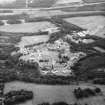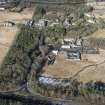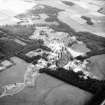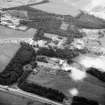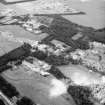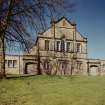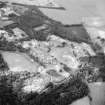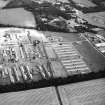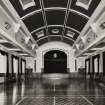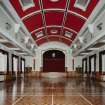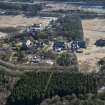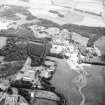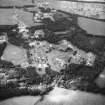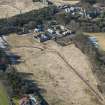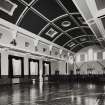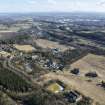Pricing Change
New pricing for orders of material from this site will come into place shortly. Charges for supply of digital images, digitisation on demand, prints and licensing will be altered.
Upcoming Maintenance
Please be advised that this website will undergo scheduled maintenance on the following dates:
Thursday, 9 January: 11:00 AM - 3:00 PM
Thursday, 23 January: 11:00 AM - 3:00 PM
Thursday, 30 January: 11:00 AM - 3:00 PM
During these times, some functionality such as image purchasing may be temporarily unavailable. We apologise for any inconvenience this may cause.
Dechmont, Bangour Village Hospital, Recreation Hall
Hall (20th Century), Psychiatric Hospital (20th Century)
Site Name Dechmont, Bangour Village Hospital, Recreation Hall
Classification Hall (20th Century), Psychiatric Hospital (20th Century)
Canmore ID 248425
Site Number NT07SW 18.04
NGR NT 03117 70848
Datum OSGB36 - NGR
Permalink http://canmore.org.uk/site/248425
- Council West Lothian
- Parish Ecclesmachan
- Former Region Lothian
- Former District West Lothian
- Former County West Lothian
Symmetrical, 7-bay Edwardian Baroque gabled and buttressed recreation hall, situated at centre of Bangour Village Hospital site, facing S. Roughly coursed and snecked stugged sandstone with smooth ashlar dressings. Base course, band course and cill course to S elevation, cornice. Some raised cills. Shouldered segmental-arched roof dormers to E and W. Pyramidal roof to N. Round-arched multi-paned windows to E and W elevations.
Bangour Village Hospital is the best surviving example in Scotland of a psychiatric hospital created in the village system of patient care, a revolutionary concept in the late 19th century. The former Recreation Hall is a well-detailed building with a fine surviving decorative interior, designed by a renowned architect and centrally located within this outstanding hospital complex. Built with Edwardian Baroque details, with rustic pilasters and a Venetian windows, the hall differs in style to the predominantly Scots Renaissance design of the rest of the hospital. Until the church was built in 1930 (see separate listing) the hall served for both secular and sacred functions and was an important addition to the creation of a village unity at the site.
The recreation hall was intended by the architect to be situated midway between the medical and the more industrial sections of the complex. It has both male and female entrances, with boot and cloakrooms at each. There is a stage with dressing rooms and there were 6 entrances to the building. There is an orchestra pit which was covered over at floor level when the building was used for dances. The hall was used for dances throughout its existence. The hall was originally intended to have a spire at the North end, but this was not built. Steel lattices were used for the roof, with no supporting columns required, which therefore extends the area of the dance floor.
Designed predominantly in a restrained Scots Renaissance style, Bangour Village Hospital is an outstanding remaining example of a psychiatric hospital built as a village and espousing a complete philosophy of care. The village system of patient care, exemplified by the Alt-Scherbitz hospital, near Leipzig in Germany in the 1870s encouraged psychiatric patients to be cared for within their own community setting, where there were few physical restrictions and where village self-sufficiency was encouraged. This was in contrast to the large contemporary asylum buildings. This philosophy had been gradually developing in a number of Scottish institutions, but Bangour saw its apotheosis, specifically in relation to psychiatric patients. Two other hospitals were built in Scotland for psychiatric patients, Kingseat, to the north of Aberdeen (built in 1904) and Dykebar Hospital in Paisley, 1909 (see separate listing). These have not survived as completely as Bangour.
The buildings of the hospital sit within their original park setting and remain largely externally unaltered.
The hospital was built by the well-known Edinburgh architect Hippolyte J Blanc as a result of a competition begun in 1898. The Edinburgh Lunacy Board had concluded that a new psychiatric hospital was required to cater for the increasing numbers of patients from Edinburgh and the hospital was opened in 1906, with some of the buildings still to be completed. It was designed with no external walls or gates. The utility buildings were positioned at the centre of the site, the medical buildings for patients requiring medical supervision and treatment were to the E and there were villas to the W of the site which could accommodate patients who required less supervision and were able to work at some sort of industry. The complex also included a farm to the NW (not part of current site) and had its own water and electricity systems and also had its own railway. The hospital was commissioned by the War Office in WWI for wounded soldiers and extra temporary structures were erected. Most of which were dismantled after the War although some timber ones were retained by the hospital. The railway too was dismantled in 1921. The patients returned in 1922. The hospital was commissioned again for WWII. At this time many temporary shelters were erected to the NW of the site and this became the basis of the Bangour General Hospital (now demolished). Bangour Village Hospital continued as a psychiatric hospital until 2004.
Hippolyte J Blanc (1844-1917) was an eminent and prolific Edinburgh-based architect who was perhaps best known for his Gothic revival churches. He was also a keen antiquarian and many of his buildings evoke an earlier Scottish style.
List description revised, 2012. The Recreation Hall was formerly listed as part of a single listing covering Bangour Village Hospital. (Historic Scotland)




























